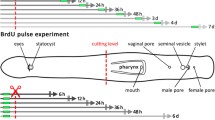Summary
-
1)
The influence of reagents affecting SH or SS groups on morphogenesis has been studied in metamorphosing larvae and in regenerating adult hydranths. The thiol challenges evoke and enhance predominantly the differentiation of basal structures.
-
2)
In larvae undergoing metamorphosis the SS-reducing agent Dithioerythrit (0.12–0.25 mM) brings about a prolongation of the subtentacular part of the body column. Dimercaptopropanol (0.19 mM), among other thiol challenges, enhances specifically stolonization giving rise to highly enlarged stolons. Under the influence of the oxidizing Kosower reagent Diamide (0.075–0.15 mM) transforming larvae develop a hypertrophied hydrorhiza which grows as a closed stolon-plate from the outset. In this way the primary polyps prematurely acquire the developmental state of sexual colonies. A correlation between the rH-values and the particular morphogenetic influences could not be established.
-
3)
According to these “vegetalizing” influences on metamorphosis the thiol challenges cause regenerating hydranths to engage, in contrast to untreated controls, in differentiation of basal structures. The hydranths develop, though only in few cases, basal structures (stalks, stolons), whereas basal parts normally are never restored. In most cases, however, Diamide and especially dimercaptopropanol impose stolonial properties on hydranths as a whole. Such hydranths transform into giant stolons and secrete a periderm without first changing their outward appearance. Thus their state of differentiation becomes totally repolarized.
-
4)
Tryptic dissociation exerts similar effects. Since all thiol reagents, at least in high doses, lead to the separation of the ectoderm and endoderm and to a partial dissociation of the tissue, it is suggested that the enhancement of basal development and the repolarization of the state of differentiation might be due to changes in cell adhesiveness and membrane properties.
Zusammenfassung
-
1.
Die Wirkung von SH- und SS-Gruppen beeinflussenden Reagenzien auf die Morphogenese wurde am Beispiel regenerierender adulter Nährpolypen und bei der Larvenmetamorphose untersucht. Die Hauptwirkung der Agentien besteht, sofern sie über eine allgemeine Schädigung hinausgeht, in der Auslösung und Verstärkung basaler Differenzierung.
-
2.
Bei Larven, die sich in der Metamorphose befinden, führt Inkubation mit dem SS-reduzierenden Reagens Dithioerythrit (0.12–0.25 mM) zu einer Verlängerung des subtentakulären Polypenabschnitts. Dimercaptopropanol (0.19 mM) verstärkt, wie auch einige andere Thiol-Reagenzien, spezifisch die Stolobildung und es wachsen stark verbreiterte Stolone aus. Unter dem Einfluß des SH-Gruppen oxidierenden Kosower-Reagens „Diamide“ entwickeln die Larven eine übermäßig vergrößerte Hydrorhiza, die sich von Anfang an als geschlossene Stolonenplatte ausbreitet. (Die Fusion der Stolone zur geschlossenen Platte geschieht normalerweise in einer späteren Phase der Stockentwicklung). Eine Korrelation zwischen den rH-Werten und den besonderen morphogenetischen Einflüssen war nicht zu erkennen.
-
3.
Gemäß diesen „vegetativisierenden“ Einflüssen auf die Metamorphose lösen die applizierten Thiol-Reagenzien bei regenerierenden Polypen die Entwicklung basaler Strukturen und Eigenschaften aus. Während unbehandelte Polypen verlorene basale Teile nicht ergänzen, können nach Behandlung mit Dithioerythrit, Dimercaptopropanol und Diamide Stiele und Stolone auswachsen. Diamide und vor allem Dimercaptopropanol führen jedoch in den meisten Fällen zu einer vollständigen Umdifferenzierung der ganzen Polypen. Ohne ihre äußeres Erscheinungsbild zu ändern, wandeln sie sich in Riesenstolone um, die eine Peridermhülle ausscheiden, Sekundärpolypen knospen und freie Stolone aussprossen lassen.
-
4.
Ähnliche Effekte wurden nach partieller tryptischer Dissoziation des Gewebes beobachtet. Da alle Reagenzien zumindestens in höherer Dosis zur Trennung von Ekto- und Endoderm und zu einer teilweisen Dissoziation führen, wird vermutet, die Verstärkung basaler Entwicklung und die Umpolarisierung des Differenzierungszustandes werde durch eine Änderung der Zellaffinitäten und der Zellmembraneigenschaften verursacht.
Similar content being viewed by others
References
Brächet, J.: The biochemistry of development. London: Pergamon Press 1960.
Campbell, R. D.: Tissue dynamics of steady state growth inHydra littoralis. II. Patterns of tissue movement. J. Morph.121, 19–28 (1967).
Cle, and, W. W.: Dithiothreitol, a new reagent for SH-groups. Biochemistry3, 480–482 (1964).
Diklstein, S.: Stimulability, adenosine triphosphatases and their control by cellular redox processes. Naturwissenschaften58, 439–443 (1971).
Hagström, B. E.: The effect of lithium and of o-iodosobenzoic acid on the early development of the sea urchin egg. Biol. Bull.124, 55–64 (1963).
Hauenschild, C.: Über die Vererbung einer Gewebeverträglichkeits-Eigenschaft bei dem HydroidpolypenHydractinia echinata. Z. Naturforsch.,11b, 132–138 (1956).
Hicklin, J., Hornbruch, A., Wolpert, L.: Inhibition of hypostome formation and polarity reversal in Hydra. Nature Lond.221, 1268–1271 (1969).
Kosower, E. M., Kosower, N. S.: Lest I forget thee, glutathione. Nature (Lond.)224, 117–120 (1969).
Lentz, Th. L.: Induction of snpernumary heads by isolated neurosecretory granules. Science150, 633–635 (1965).
Lesh, C. E., Burnett, A. L.: An analysis of the chemical control of polarized form in hydra. J. exp. Zool.163, 55–78 (1966).
Müller, W. A.: Experimentelle Untersuchungen über Stockentwicklung, Polypendifferenzierung und Sexualchimären beiHydractinia echinata. Wilhelm Roux' Archiv Entwickl.- Mech. Org.155, 181–268 (1964).
Müller, W. A.: Die Steuerung des morphogenetischen Fließgleichgewichts in den Polypen vonHydractinia echinata. I. Biologisch-experimentelle Untersuchungen. Wilhelm Roux' Archiv163, 334–356 (1969a).
Müller, W. A.: Die Steuerung des morphogenetischen Fließgleichgewichts in den Polypen vonHydractinia echinata. II. Chemisch-analytische Untersuchungen. Wilhelm Roux' Archiv163, 357–374 (1969b).
Müller, W. A.: Auslösung der Metamorphose durch Bakterien bei den Larven vonHydractinia echinata. Zool. Jb. Abt. Anat. u. Ontog.86, 84–95 (1969c).
Müller, W. A., Spindler, K.-D.: The “Polarizing Inducer” in Hydra: A reexamination of its properties and its origin. Wilhelm Roux' Archiv167, 325–335 (1971).
Robinson, J. D.: Interaction between protein sulphydryl groups and lipid double bonds in biological membranes. Nature (Lond.)212, 199–200 (1966).
Spindler, K.-D., Müller, W. A.: Induction of metamorphosis by bacteria and by a lithium-pulse in the larvae ofHydactinia, echinata. Wilhelm Roux' Archiv,169, 271–280 (1972).
Wolfson, N., Fry, D. S.: The effect of oxidized lipoic acid on developing echinoderm embryos. Exp. Cell Res.38, 66–74 (1965).
Author information
Authors and Affiliations
Rights and permissions
About this article
Cite this article
Müller, W.A., Spindler, K.D. The effects of sulphydryl reagents on morphogenesis in hydroids. Wilhelm Roux' Archiv 170, 152–164 (1972). https://doi.org/10.1007/BF00577014
Received:
Issue Date:
DOI: https://doi.org/10.1007/BF00577014




